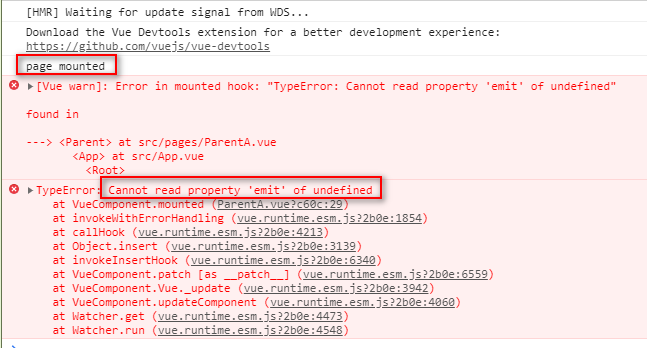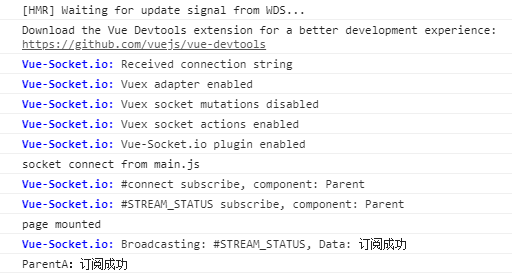vue-socket.io使用教程與踩坑記錄
全手打原創,轉載請標明出處:https://www.cnblogs.com/dreamsqin/p/12018866.html,多謝,=。=~
(如果對你有幫助的話請幫我點個贊啦)
請先允許我狠狠吐個槽:vue-socket.io相關中文部落格實在太少太少,來來去去就那麼幾篇,教程也比較零散,版本也比較老,就算我有暴風式搜尋還是找不到解決問題的方案,然後我怒了,開始看原始碼、寫測試demo、幾乎把相關的issues都看了一遍,折騰1天后終於。。。搞定了,下面總結一下~
前言
vue-socket.io其實是在socket.io-client基礎上做了一層封裝,將$socket掛載到vue例項上,同時你可以使用sockets物件
vue-socket.io:3.0.7,可以在其package.json中看到它依賴於socket.io-client:2.1.1。
我遇到的問題
websocket連線地址是從後端動態獲取,所以導致頁面載入時VueSocketIO例項還未建立,頁面中通過this.$socket.emit發起訂閱報錯,同時無法找到vue例項的sockets物件(寫在內部的事件將無法監聽到,就算後面已經連線成功)
如果你的websocket連線地址是靜態的(寫死的),可以只看使用教程,如果你跟我遇到了同樣的問題,那就跳躍到解決方案
console報錯如下:

使用教程
先拋開可能遇到的問題,按照官網的教程我們走一遍:
安裝
npm install vue-socket.io --save
引入(main.js)
import Vue from 'vue' import store from './store' import App from './App.vue' import VueSocketIO from 'vue-socket.io' Vue.use(new VueSocketIO({ debug: true, connection: 'http://metinseylan.com:1992', vuex: { store, actionPrefix: 'SOCKET_', mutationPrefix: 'SOCKET_' }, options: { path: "/my-app/" } //Optional options })) new Vue({ router, store, render: h => h(App) }).$mount('#app')
debug:生產環境建議關閉,開發環境可以開啟,這樣你就可以在控制檯看到socket連線和事件監聽的一些資訊,例如下面這樣:

connection:連線地址字首,注意!這裡只有字首,我之前被坑過,因為明明後端有給我返回上下文,但莫名其妙的被去除了,vue-socket.io這裡用到的是socket.io-client的Manager api,關鍵原始碼如下(只看我寫中文備註的部分就好):
vue-socket.io(index.js)
import SocketIO from "socket.io-client";
export default class VueSocketIO {
/**
* lets take all resource
* @param io
* @param vuex
* @param debug
* @param options
*/
constructor({connection, vuex, debug, options}){
Logger.debug = debug;
this.io = this.connect(connection, options); // 獲取到你設定的引數後就呼叫了connect方法
this.useConnectionNamespace = (options && options.useConnectionNamespace);
this.namespaceName = (options && options.namespaceName);
this.emitter = new Emitter(vuex);
this.listener = new Listener(this.io, this.emitter);
}
/**
* registering SocketIO instance
* @param connection
* @param options
*/
connect(connection, options) {
if (connection && typeof connection === "object") {
Logger.info(`Received socket.io-client instance`);
return connection;
} else if (typeof connection === "string") {
const io = SocketIO(connection, options);// 其實用的是socket.io-client的Manager API
Logger.info(`Received connection string`);
return (this.io = io);
} else {
throw new Error("Unsupported connection type");
}
}socket.io-client(index.js)
var url = require('./url');
function lookup (uri, opts) {
if (typeof uri === 'object') {
opts = uri;
uri = undefined;
}
opts = opts || {};
var parsed = url(uri); // 通過url.js對connection字首進行擷取
var source = parsed.source;
var id = parsed.id;
var path = parsed.path;
var sameNamespace = cache[id] && path in cache[id].nsps;
var newConnection = opts.forceNew || opts['force new connection'] ||
false === opts.multiplex || sameNamespace;
var io;
if (newConnection) {
debug('ignoring socket cache for %s', source);
io = Manager(source, opts);
} else {
if (!cache[id]) {
debug('new io instance for %s', source);
cache[id] = Manager(source, opts);
}
io = cache[id];
}
if (parsed.query && !opts.query) {
opts.query = parsed.query;
}
return io.socket(parsed.path, opts);// 實際呼叫的是解析後的字首地址
}options.path: 這裡就可以填websocket連線地址的字尾,如果不填會被預設新增/socket.io,關鍵原始碼如下(只看我寫中文備註的部分就好):
其他的options配置可以參見https://socket.io/docs/client-api/#Manager
socket.io-client(manager.js)
function Manager (uri, opts) {
if (!(this instanceof Manager)) return new Manager(uri, opts);
if (uri && ('object' === typeof uri)) {
opts = uri;
uri = undefined;
}
opts = opts || {};
opts.path = opts.path || '/socket.io'; // 看到沒有,如果你不傳遞options.path引數的話會被預設安一個尾巴"/socket.io"
this.nsps = {};
this.subs = [];
this.opts = opts;
this.reconnection(opts.reconnection !== false);
this.reconnectionAttempts(opts.reconnectionAttempts || Infinity);
this.reconnectionDelay(opts.reconnectionDelay || 1000);
this.reconnectionDelayMax(opts.reconnectionDelayMax || 5000);
this.randomizationFactor(opts.randomizationFactor || 0.5);
this.backoff = new Backoff({
min: this.reconnectionDelay(),
max: this.reconnectionDelayMax(),
jitter: this.randomizationFactor()
});
this.timeout(null == opts.timeout ? 20000 : opts.timeout);
this.readyState = 'closed';
this.uri = uri;
this.connecting = [];
this.lastPing = null;
this.encoding = false;
this.packetBuffer = [];
var _parser = opts.parser || parser;
this.encoder = new _parser.Encoder();
this.decoder = new _parser.Decoder();
this.autoConnect = opts.autoConnect !== false;
if (this.autoConnect) this.open();
}vuex: 配置後可以在store.js的mutations或者actions監聽到Vue-Socket.io事件(例如:connect、disconnect、reconnect等),這部分目前用得比較少,也挺簡單,如果有疑問可以給我留言我再單獨提供教程。使用(Page.vue)
注意:熟悉socket.io-client的應該知道,預設情況下,websocket在建立例項的時候就會自動發起連線了,所以切記不要在元件中重複發起連線。如果你想自己控制發起連線的時機可以將options.autoConnect設定為false。
export default {
name: 'Page',
sockets: {// 通過vue例項物件sockets實現元件中的事件監聽
connect: function () {// socket的connect事件
console.log('socket connected from Page')
},
STREAM_STATUS(data) {// 後端按主題名推送的訊息資料
console.log('Page:' + data)
}
},
mounted() {
console.log('page mounted')
this.$socket.emit('STREAM_STATUS', { subscribe: true })// 在頁面載入時發起訂閱,“STREAM_STATUS”是你跟後端約定好的主題名
}
}事件除了在sockets物件中預設監聽,你還可以在外部單獨註冊事件監聽或取消註冊:
this.sockets.subscribe('EVENT_NAME', (data) => {
this.msg = data.message;
});
this.sockets.unsubscribe('EVENT_NAME');但這種方式從原始碼上看是不支援引數傳遞的,只支援傳遞事件名及回撥函式(部分原始碼如下):
vue-Socket.io(mixin.js)
beforeCreate(){
if(!this.sockets) this.sockets = {};
if (typeof this.$vueSocketIo === 'object') {
for (const namespace of Object.keys(this.$vueSocketIo)) {
this.sockets[namespace] = {
subscribe: (event, callback) => {
this.$vueSocketIo[namespace].emitter.addListener(event, callback, this);
},
unsubscribe: (event) => {
this.$vueSocketIo[namespace].emitter.removeListener(event, this);
}
}
}
} else {
this.$vueSocketIo.emitter.addListener(event, callback, this);
this.$vueSocketIo.emitter.removeListener(event, this);
}
}解決方案
針對我上面描述的問題,最大原因就在於獲取socket連線地址是非同步請求,如文章開頭的截圖,page mounted列印時,this.$socket還是undefined。所以我們要做的就是怎麼樣讓頁面載入在VueSocketIO例項建立之後。
我提供兩種解決方案,具體怎麼選擇看你們的需求~
保證拿到socket連線地址後再將vue例項掛載到app
缺點:如果你獲取socket地址的請求失敗了,整個專案的頁面都載入不出來(一般伺服器出現問題才會有這種情況產生)
優點:實現簡單,一小段程式碼挪個位置就好
main.js
import Vue from 'vue'
import App from './App.vue'
import router from './router'
import store from './store'
import ParentApi from '@/api/Parent'
import VueSocketIO from 'vue-socket.io'
/* 使用vue-socket.io */
ParentApi.getSocketUrl().then((res) => {
Vue.use(new VueSocketIO({
debug: false,
connection: res.data.path,
options: { path: '/my-project/socket.io' }
}))
new Vue({
router,
store,
render: h => h(App)
}).$mount('#app')
})控制檯列印如下圖:

結合connect事件+store+路由守衛實現攔截
原理:非同步請求回撥中建立VueSocketIO例項並監聽connect事件,監聽回撥中修改isSuccessConnect引數的值,在Page頁面路由中增加beforeEnter守衛,利用setInterval週期性判斷isSuccessConnect的值,滿足條件則取消定時執行並路由跳轉。
缺點:實現起來稍微複雜一點
優點:不會影響其他頁面的載入
main.js
import Vue from 'vue'
import App from './App.vue'
import router from './router'
import store from './store'
import ParentApi from '@/api/Parent'
import VueSocketIO from 'vue-socket.io'
ParentApi.getSocketUrl().then((res) => {
let vueSocketIo = new VueSocketIO({
debug: false,
connection: res.data.path,
options: { path: '/my-project/socket.io' }
})
// 監聽connect事件,設定isSuccessConnect為true
vueSocketIo.io.on('connect', () => {
console.log('socket connect from main.js')
store.commit('newIsSuccessConnect', true)
})
Vue.use(vueSocketIo)
})
new Vue({
router,
store,
render: h => h(App)
}).$mount('#app')store.js
import Vue from 'vue'
import Vuex from 'vuex'
Vue.use(Vuex)
export default new Vuex.Store({
state: {
// socket連線狀態
isSuccessConnect: false
},
mutations: {
newIsSuccessConnect(state, value) {
state.isSuccessConnect = value
}
},
getters: {
getIsSuccessConnect: state => {
return state.isSuccessConnect
}
},
actions: {
}
})router.js
import Vue from 'vue'
import Router from 'vue-router'
import store from './store'
Vue.use(Router)
export default new Router({
mode: 'history',
base: process.env.BASE_URL,
routes: [
{
path: '/page',
name: 'Page',
component: () => import(/* webpackChunkName: "Page" */ './pages/Page.vue'),
beforeEnter: (to, from, next) => {
let intervalId = setInterval(() => {
// 直到store中isSuccessConnect為true時才能進入/page
if (store.getters.getIsSuccessConnect) {
clearInterval(intervalId)
next()
}
}, 500)
}
}
]
})控制檯列印如下圖:

參考資料:
1、vue-socket.io:https://github.com/MetinSeylan/Vue-Socket.io
2、socket.io-client:https://github.com/socketio/socket.io-client
3、vue-router守衛:https://router.vuejs.org/zh/guide/advanced/navigation-guards.html#%E8%B7%AF%E7%94%B1%E7%8B%AC%E4%BA%AB%E7%9A%84%E5%AE%88%E5%8D
